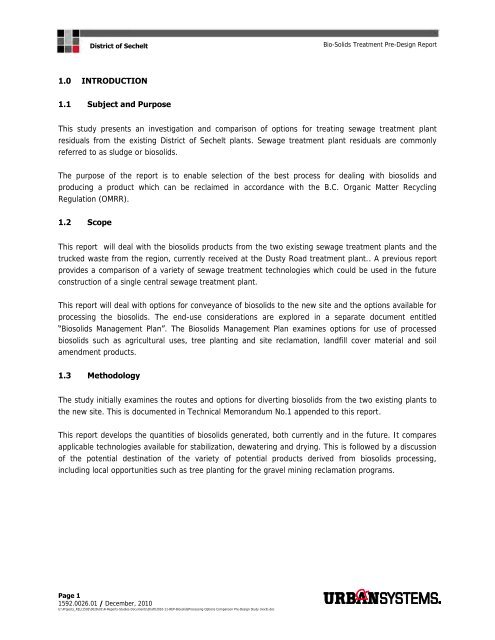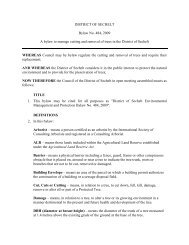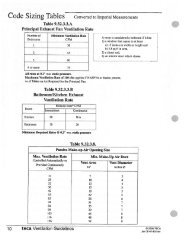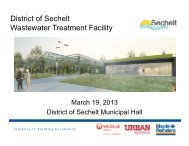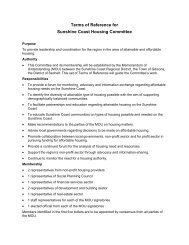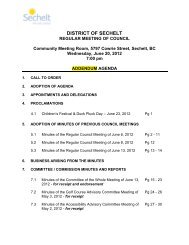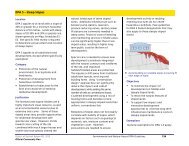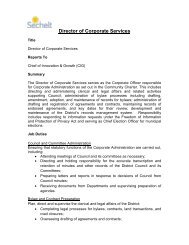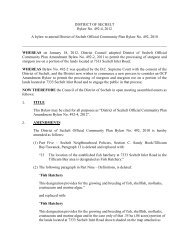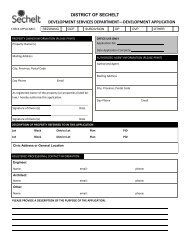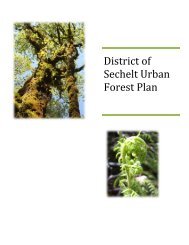District of Sechelt Preliminary Report
District of Sechelt Preliminary Report
District of Sechelt Preliminary Report
You also want an ePaper? Increase the reach of your titles
YUMPU automatically turns print PDFs into web optimized ePapers that Google loves.
<strong>District</strong> <strong>of</strong> <strong>Sechelt</strong><br />
Bio-Solids Treatment Pre-Design <strong>Report</strong><br />
1.0 INTRODUCTION<br />
1.1 Subject and Purpose<br />
This study presents an investigation and comparison <strong>of</strong> options for treating sewage treatment plant<br />
residuals from the existing <strong>District</strong> <strong>of</strong> <strong>Sechelt</strong> plants. Sewage treatment plant residuals are commonly<br />
referred to as sludge or biosolids.<br />
The purpose <strong>of</strong> the report is to enable selection <strong>of</strong> the best process for dealing with biosolids and<br />
producing a product which can be reclaimed in accordance with the B.C. Organic Matter Recycling<br />
Regulation (OMRR).<br />
1.2 Scope<br />
This report will deal with the biosolids products from the two existing sewage treatment plants and the<br />
trucked waste from the region, currently received at the Dusty Road treatment plant.. A previous report<br />
provides a comparison <strong>of</strong> a variety <strong>of</strong> sewage treatment technologies which could be used in the future<br />
construction <strong>of</strong> a single central sewage treatment plant.<br />
This report will deal with options for conveyance <strong>of</strong> biosolids to the new site and the options available for<br />
processing the biosolids. The end-use considerations are explored in a separate document entitled<br />
“Biosolids Management Plan”. The Biosolids Management Plan examines options for use <strong>of</strong> processed<br />
biosolids such as agricultural uses, tree planting and site reclamation, landfill cover material and soil<br />
amendment products.<br />
1.3 Methodology<br />
The study initially examines the routes and options for diverting biosolids from the two existing plants to<br />
the new site. This is documented in Technical Memorandum No.1 appended to this report.<br />
This report develops the quantities <strong>of</strong> biosolids generated, both currently and in the future. It compares<br />
applicable technologies available for stabilization, dewatering and drying. This is followed by a discussion<br />
<strong>of</strong> the potential destination <strong>of</strong> the variety <strong>of</strong> potential products derived from biosolids processing,<br />
including local opportunities such as tree planting for the gravel mining reclamation programs.<br />
Page 1<br />
1592.0026.01 / December, 2010<br />
U:\Projects_KEL\1592\0026\01\R-<strong>Report</strong>s-Studies-Documents\Draft\2010-11-REP-BiosolidsProcessing Options Comparison Pre-Design Study (rev3).doc


